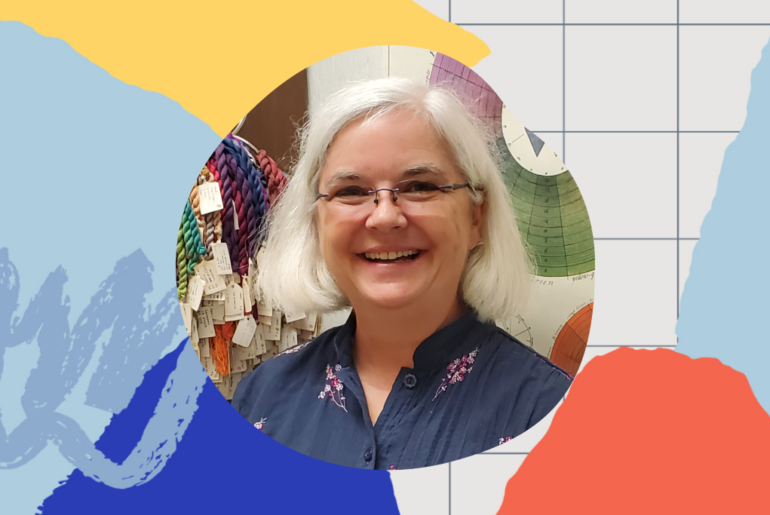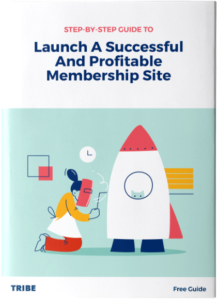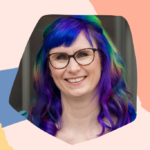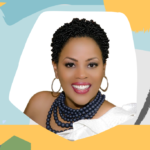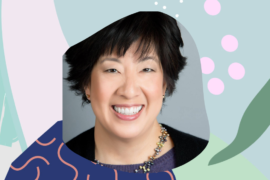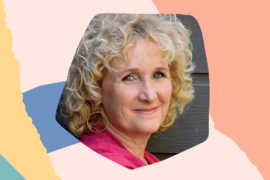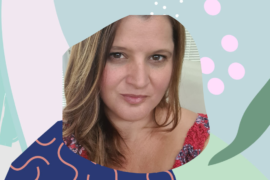Jean Haley worked with university researchers to reach farmers, growers, and other important players in the world of sustainable agriculture. Though she loved her work, losing several loved ones in rapid succession made her realize she didn’t want to be staring at data for the rest of her life – and she set out to become a full-time artist.
To make this a possibility and empower others just like her, Jean has built a membership through the Naturally Dyed Wool Bundle monthly subscription. She sends fellow wool crafters sustainable, all-natural materials, allowing them to build their stash of crafting gear while helping the planet at the same time.
Today, Jean joins the podcast to share the story of how she found the courage to reinvent herself after 15 years, launched her membership business, and built a powerful community along the way.
Key Takeaways
- The moment Jean realized there wasn’t another day promised to anyone – and how this revelation changed her life and career forever.
- How Jean used her artistic passion to inspire her membership site, carve out a unique niche, and differentiate herself from others in similar fields.
- Why fear of success is just as dangerous as fear of failure.
- Why time is the biggest gift we can give ourselves.
Free Give
FREE Guide – Launch & Grow a Profitable Membership Site
Ready to reclaim your time and attract more monthly paying customers? Our step-by-step guide will show you how to build a membership site that turns your passion into recurring profit. Click here to download!
Memorable Quote
- “For me, fear has very rarely been a failure. Often, it’s a feeling of fear of success.” – Jean Haley
- “In the grand scheme of things, the stakes are so low. Just go for it. Put it out there and learn.” – Jean Haley
Episode Resource
Transcript
Read The Transcript[INTERVIEW]
Shelli Varela: Jean Haley, welcome to the It’s a TRIBE Thing Podcast. How are you, my friend?
Jean Haley: I’m doing great. Thanks. Thanks for having me.
Shelli Varela: I’m really excited to have you because, in our pre-chat, I know we were talking about one of my favorite topics, which is time and the creative versus logical brain. And I’m super excited to share you with our audience because I know there is going to be so much that resonates with them. So, thank you again for being here. And right off the top, would you please let us know what you do and who you serve?
Jean Haley: So, I currently have a subscription box. My current subscription is for wool crafters who love the environment. I help wool crafters build their stash in an ecofriendly way. I do this with naturally dyed wool bundles.
Shelli Varela: It’s such a like yummy and sexy thing when you’re loving on the environment and doing what you love at the same time. Your backstory is really cool, though. Can you share with everybody who you were before you were into the fiber arts and had a membership site and were the person that we’re speaking to today? How did that all come to be?
Jean Haley: Sure. So, I am an independent consultant. I’ve been on my own since 2001. I’m a social scientist. I do program evaluation. I work with people who have gotten grants and I help them evaluate their programs. And what I mainly do is help them make sure that they work for their intended audience. In my case, that’s in sustainable agriculture and it’s been really great and exciting work. I get to work with wonderful university researchers. They’re doing wonderful work and I help them make sure that their information gets to farmers and growers in a way that the farmers and growers are going to digest it and want to actually change their behavior or adopt new practices. So, that’s been fun and exciting work but I don’t love, love, love it. I am a kind of a data nerd but it has its limits. And it was about five years ago when I had lost some special people in my life and the last straw for me was when a friend named Ray was diagnosed with ALS and that was a huge wake-up call for me. Ray was a super alive, vibrant, active, wonderful human and he got this awful degenerative disease.
And it was just a wake-up call to me to remind me that we’re not guaranteed another day. I could wake up tomorrow and be diagnosed with ALS or cancer or something awful, and not know or get hit by a bus. Who knows? And so, when I was sitting there at my computer, working my datasheets, and analyzing and I thought, “Whoa, is this what I want to be doing when I die?” And I thought, “No, no, this is not what I want to be doing. I want to be an artist full-time.” I want to be an artist full-time. Let’s figure this out. I’ve been self-employed for almost 20 years, well, 15 years at that point. I could figure this out but I didn’t really know how to do it. So, I’ve been working on it for about five years and make that transition.
Shelli Varela: I just want to jump in on that because I know this is a theme that we hear over and over and over again, especially as we’re growing up. The creative sort of inspiration that lives in all of us oftentimes is seen as something that’s fun or it’s a hobby or it’s something that we like to do. And there is a cost to shelving that which lights you up. There is a cost of shelving that brings you alive, and oftentimes we’re steered towards something we shouldn’t do because it’s logical or it’s practical, or it’s whatever in that sort of this is going to give you a sustainable, practical stable job, income, employment, whatever. Can you talk about that journey? Because I know that you had mentioned you would work with your mom and she always wanted to teach you rug hooking and for you growing up the arts were something you were going to do after you retired.
Jean Haley: Right. Yes.
Shelli Varela: Take us on that journey if you would.
Jean Haley: Sure. So, I was always a really creative kid and my mom taught me how to do the knitting and crocheting and the needle pointing and all the things and I always loved art but I never thought of it as a career. It just didn’t seem like an option for a career. I even took an oil class in college and it still didn’t occur to me that I could be an artist. But I just got lost there in my story. Can you remind me that question? Sorry.
Shelli Varela: Yeah, absolutely. We were talking about how your mum was asking you about hooking and creativity was something that you just kind of did for fun.
Jean Haley: Right. Yeah. So, creativity was, yeah, it was a fun thing. It was a thing that kind of kept me sane and you talked a little bit about mental health. Yeah, definitely, I suffer from depression and I’m on meds for that and if I had not been creative, then that’s a problem but I had this dream that I would work and earn enough money to be able to retire by 50 so that I could then go to school at the Art Institute in Chicago and become an artist for the rest of my life and that would be kind of my dream sort of retirement where I’d be an artist. It still wasn’t sort of a this could be a career for me. My mom taught me how to hook about 15 years ago. I resisted for a long time because I needed another craft like I needed another hole on the head.
Shelli Varela: But when you say hooking, what do you mean just so everybody can follow?
Jean Haley: Yeah. So, rug hooking, it’s a craft that was actually born in The Maritimes, East Coast, Northeast of the US, The Maritimes in Canada and it’s a craft where back in the day you would wear your clothes until you couldn’t wear them any longer and you couldn’t mend them any longer. And then what they would do is they would cut their shirts or their trousers or whatever, which were always wool because it’s the Maritimes and they would cut them into strips, and they would pull them through a burlap, a sack like a potato sack backing, and they would make rugs out of them. Well, nowadays, we don’t do as much of that although there are many of us who do. We try to recycle and upcycle our clothes but I use a linen backing and I dye wool fabric and then I cut it into strips and I make designs out of it into beautiful rugs or things that you can hang on your wall or coasters or trivets or whatever your brain can imagine we can figure it out how to do it.
Shelli Varela: So, when you talk about you would experience being around death and dying and watching the people surrounding you passing and also your friend, Ray, who’s diagnosed with ALS, was that the moment when you said to yourself, “Okay. What is it costing me to not do that which lights me on fire?” Was that the moment that you became aware of that dream you had, “Oh, well, when I’m 50, I’m going to become an artist so then I can do the thing that I love?” Was that the moment when it switched on for you and you had the epiphany that I maybe can just do this because I can do this?
Jean Haley: Yeah, absolutely. That was really the wake-up moment for me. Yeah, I did not want to be doing data for the rest of my days. I just couldn’t see that and I thought I have been making my way in the world by myself as an independent consultant for at that time, 15 years. I can figure out how to do this. And because I was gainfully employed, I’m very fortunate. I decided I could make that transition. Well, what if I pulled back on some of my clients and some of my contracts and take fewer of those and work more on my art and start figuring out how to sell that and make money off of that and how do I build a business plan around the art so that I can make that transition? I wasn’t ready to just like quit my day job. If I could have, yay, but that’s just not realistic for me. I’m not independently wealthy. I do still need to work for the mortgage. And so, I knew in my brain that I could figure this out. Somehow, I needed some help but I thought I can make this transition. There are a ton of people making a living at art in the world. There are more than just one, right?
I mean, so if they can do it, why can’t I do it? I don’t need to be Picasso. There’s plenty of artists out there who aren’t going to be making Chagall stained glass windows or making tapestries that are going to hang in the Louvre but they’re making a living doing what they love to do and using that creativity. And for me, it’s about bringing joy to the world and saving the planet too because I love the environment.
Shelli Varela: Absolutely. So, what did that look like when you had that moment where you switched on and you say to yourself, “Wow, like this is going to be my thing. I’m a smart woman. I’ve built a business before. I know how to do this.” How did that which you love turn into a membership site? What did that transition or that thought process look like for you?
Jean Haley: There were a few steps to get there really. I started taking online business courses and all the things that I did when I first started consulting on my own as well. It’s like how do I do this business? Well, I didn’t know how to do that for art. And one of the classes that I, one of the programs that I’m part of is Carrie Greene’s Female Entrepreneurship Association. And she introduced us to TRIBE and this spring, she encouraged us to sign up for Stu’s free webinar series. At that point, I had already been thinking about taking my – I teach natural dyes. I teach how to natural dye as well as selling my naturally dyed wool and creating art with my naturally dyed wool. I was having problems with getting people to my classes, my in-person classes because of time. Nobody has time. Everybody would talk about how much they wanted to take my classes, “I want to be there. I want to be there,” but they couldn’t make it at that specific time. And so, I thought I need to make this an online course. Somehow, I need to do that. And so, when I first signed up for TRIBE, I originally thought, “All right. This is what I’m going to do is I’m going to make this course an online course and it’s going to be an upfront,” I didn’t have a language for it at that point but it’s going to be an upfront course with the backend membership so that I could create this community of natural dyers in the wool world, in the world that I’m in.
There’s a lot of knitters and crocheters, and they’re all up on it. The yarn folks are all up and doing the environmental eco plant dyes but fewer of the hookers and applicators are doing that. So, I wanted to create this great, big, beautiful community of wool crafters using naturally dyed wool fiber. And as I got in, time got tight. Life happens and so I thought, “Well, I can start with a subscription box first.” This seemed less daunting to me. I could like have a wool bundle that I would send out to my members once a month and that would be kind of an introductory and then that would also hopefully be a magnet for encouraging people to want to learn how to do the natural dyeing themselves. And so, I could then take some of those people into my coursework and then into the back end membership. So, it’s kind of discombobulated and I’m not sure I went about it the right way but it’s the right way for me right now.
I did a founding member launch. There was that Stu gave away that little recipe. He’s done it on his podcast as well but he gave away that recipe during the free webinar about how to do a founding member launch and I kept thinking, “I’m going to do this, I’m going to do this, I’m going to do this, I’m going to do this,” and I never was doing it. When I was in TRIBE after I signed up for TRIBE, which I almost did not do because I missed that last day because my mother died. So, that was another reminder of we do not have time here. Let’s get this moving. I almost didn’t sign up thinking, “Oh, I’ll just wait until next year,” and then I realized, “You know what, in another month or two, I’m going to be really sorry I didn’t sign up for this.” And I was right. And so, I became part of TRIBE. In the membership on the Facebook page, there were people talking about their founding member launches and there are some really daunting figures out there with like, “We got 1,000 people la, la, la,” and I’m like, “Oh my God, that’s so not me. If I got 1,000 people, I would die.” I mean, I can only dye so much wool in a month.
Shelli Varela: Right.
Jean Haley: I’m just one human. I just need enough people to learn from. And there was a post and there were a couple of us who are kind of going back and forth on, “Yeah, me too. I’m really scared. Me, I don’t know and I’m afraid and I keep saying I’m going to do it and I don’t do it.” And so, a couple of us said, “Okay. Let’s just do it. Let’s say next Wednesday, we’re going to do it.” And so, I did it and I would do it completely differently now but I was hoping for two, and 10 would have been like out of the ballpark for me and I got 10 people and it was just so surprising and it was so exciting. The crazy part for me was that eight of those 10 people signed up for the annual membership and I just thought, “Whoa, there are eight people who are in for the long. I’m in now. I better make this work.” So, this just happened this summer. I just did my founding member launch in July. There have been three boxes, August, September, October. The most recent boxes went out last week. And so, I’ve been working with these 10 people on building their stash. And for me learning from them about what makes a good subscription membership, and what works for them, and how I can best serve them.
And some of the things that I thought they’d like they were like, “Nah, not so much,” and other things they’re like, “Oh, well, what if you did this?” Like, “Oh, yeah, I could probably do that, too. Let’s figure that out.” And so, I’m getting ready now with their help and their feedback to launch again to the rest of the world. I have a cap, of course, because, again, I’m one person and I can only dye so much wool in a month that I want to share. Of course, I want to keep some for myself for my own art. So, I do have a cap on it but I’m hoping to relaunch soon. And with the feedback from my founding members, I am hoping that it will be very successful. At the same time, we met Amy Porterfield through Stu and TRIBE. And so, I’ve signed up for her Digital Course Academy so that I can build that. The original idea was the natural dye online workshop. And so, Stu and Amy have teamed up to provide some extra bonuses to really marry these two programs together and I’m so excited about the possibilities for that. And that should launch in early January, hopefully. Fingers crossed.
Shelli Varela: Well, this is brilliant. And I wanted to ask you this because there are so many people sitting on so many gifts. And so, for you before you did your founding member launch, two things, we typically set a, well, here’s my low middle or this would be an absolute dream if I got this many members sort of like a sliding scale. So, first of all, like what does it feel like to have hit it out of the park? And also, for those people who are listening right now who are sitting on the fence with their toes on the line and they want to do it and they’re waiting and they’re procrastinating, what does it feel like to hit it out of the park? And what advice would you give those people who are waiting to start?
Jean Haley: It was really exciting and also a little scary because that meant I had to make it happen. For me, the fear is very rarely been a failure. For me, often it’s a feeling of fear of success. It’s like, “Oh my God, I have to be this person now and I have to make that so.” So, it was a little bit scary but it was so incredibly exciting and it was really validating to have these people sign up and express interest in what I want to share. So, if you’re on the fence, just go for it. And honestly, even if I’d only hit two or even if I’d hit none, I think I would have learned so much from that experience just getting it out there. I mean, what’s the worst thing that’s going to happen? I’m not going to kill anybody. Nobody’s going to die from this, right? The stakes are really low to put a founding member launch out. I might lose a little face but even there not very many people knew about it. I have a mailing list of less than 200. And so, really not that many people knew that I was putting this founding member launch out there. And so, in the grand scheme of things, the stakes are so low. Just go for it. Put it out there and learn.
Shelli Varela: Absolutely. And also coupled with what we know about time, we never know how much of it we have and regret is a heavy burden to carry. Last question, what is the biggest gift that you received from saying yes to that?
Jean Haley: Oh my gosh, getting to interact with these fiber artists, these wool crafters. The best part was that they weren’t all people that I knew. And so, that was really exciting, and learning about these other people and what they do with their wool craft is just so exciting and rewarding and inspiring. It inspires and motivates me to want to do more and give more and create more and look at things in new and different ways. I think that’s probably the greatest gift is an increased desire to want to serve, which I think I already had, but it’s something about it being validated is a huge gift.
Shelli Varela: Absolutely. When you take a chance and it works out and you realize it wasn’t as scary as you thought it was before you started.
Jean Haley: Right.
Shelli Varela: That’s brilliant. Thank you so much for sharing your story. So many gems that people can learn from and value that we can pull and things that other people can activate on as well. If people are looking to contact you or they want to be part of your world, your membership, where’s the best place they can find you online?
Jean Haley: Best place they can find me online is right now would probably be Instagram. It’s jean.haley. My website is JeanHaleyDesign.com. It’s currently getting revamped so I’m not sure when this is going to air but that’s another place to go. So, those are the two top places I post regularly on Instagram. And you can check out my wool and other things on my website.
Shelli Varela: Perfect. Well, we will definitely see you there and we’re so grateful for your time. Thanks so much, buddy.
[END]
To learn more and get access to all episodes, visit our podcast page!
